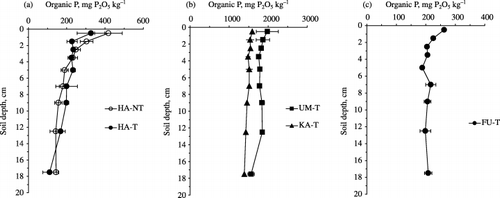Figures & data
Table 1 Locations, soil classification and P fertilizer rates of the paddy fields studied
Figure 1 The sampling positions (shaded bars) of soils after harvest for UM-T, KA-T and FU-T from above (a) and vertically (b) from the arrow side of (a). ×, rice stubbles (a); – in (a) and • in (b); the positions of P application through nozzles equipped with the transplanting machine. Schematic representation of depth and width of the soil sampling pit (b).

Table 2 Soil properties of Ap horizon (0–10 cm) in paddy fields after harvest
Figure 2 Vertical distribution of total carbon (C) in soils which were sampled from the five paddy rice fields as semi-micro thin layers of 0–1, 1–2, 2–3, 3–4, 4–6, 6–8, 8–10, 10–15 and 15–20 cm from the soil surface. (a) No-tillage Hachirougata soil (HA-NT), conventional-tillage Hachirougata soil (HA-T). (b) Conventional-tillage Utsunomiya soil (UM-T), conventional-tillage Kawatabi soil (KA-T), conventional-tillage Furukawa soil (FU-T). Error bars show standard deviation (a: n= 3; b: n= 2).
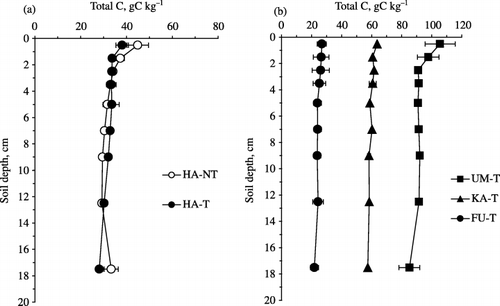
Figure 3 Vertical distribution of total nitrogen (N) in soils which were sampled from the five paddy rice fields as semi-micro thin layers of 0–1, 1–2, 2–3, 3–4, 4–6, 6–8, 8–10, 10–15 and 15–20 cm from the soil surface. (a) No-tillage Hachirougata soil (HA-NT), conventional-tillage Hachirougata soil (HA-T). (b) Conventional-tillage Utsunomiya soil (UM-T), conventional-tillage Kawatabi soil (KA-T), conventional-tillage Furukawa soil (FU-T). Error bars show standard deviation (a: n= 3; b: n= 2).
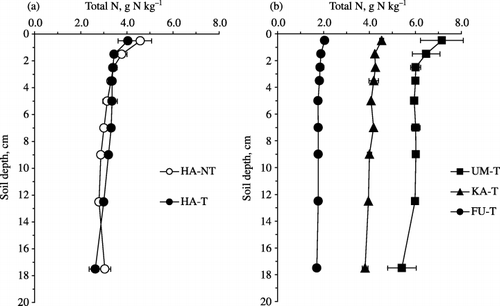
Figure 4 Vertical distribution of total phosphorus (P) in soils which were sampled from the five paddy rice fields as semi-micro thin layers of 0–1, 1–2, 2–3, 3–4, 4–6, 6–8, 8–10, 10–15 and 15–20 cm from the soil surface. (a) No-tillage Hachirougata soil (HA-NT), conventional-tillage Hachirougata (HA-T). (b) Conventional-tillage Utsunomiya soil (UM-T), conventional-tillage Kawatabi soil (KA-T), conventional-tillage Furukawa soil (FU-T). Error bars show standard deviation (a: n= 3; b: n= 2).
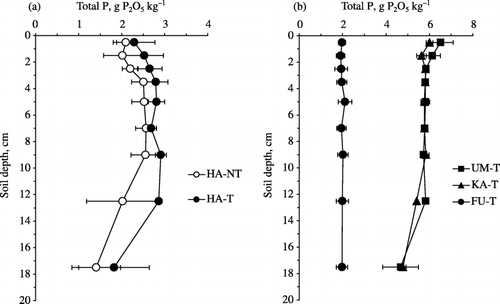
Figure 5 Vertical distribution of Bray II P in soils which were sampled from the five paddy rice fields as semi-micro thin layers of 0–1, 1–2, 2–3, 3–4, 4–6, 6–8, 8–10, 10–15 and 15–20 cm from the soil surface. (a) No-tillage Hachirougata soil (HA-NT), conventional-tillage Hachirougata soil (HA-T). (b) Conventional-tillage Utsunomiya soil (UM-T), conventional-tillage Kawatabi soil (KA-T), conventional-tillage Furukawa soil (FU-T). Error bars show standard deviation (a: n= 3; b: n= 2).
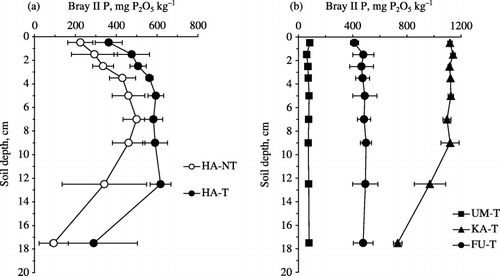
Table 3 Ratios of Bray II P and Organic P to total P in the five paddy soils
Figure 6 Vertical distribution of organic phosphorus (P) in soils which were sampled from the five paddy rice fields as semi-micro thin layers of 0–1, 1–2, 2–3, 3–4, 4–6, 6–8, 8–10, 10–15 and 15–20 cm from the soil surface. (a) No-tillage Hachirougata soil (HA-NT), conventional-tillage Hachirougata soil (HA-T). (b) Conventional-tillage Utsunomiya soil (UM-T), conventional-tillage Kawatabi soil (KA-T). (c) Conventional-tillage Furukawa soil (FU-T). Error bars show standard deviation (a: n= 3; b: n= 2; c: n= 2).
